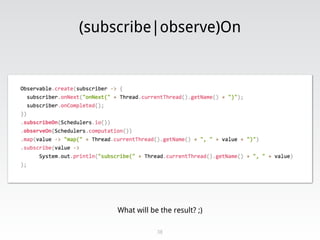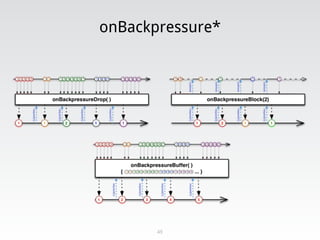RxJava - introduction & design
- 1. 1 Mateusz Gajewski Solutions Architect @ Allegro Kraków Office Opening • February 2015 allegrotech.io, twitter: @allegrotechblog RxJava Reactive eXtensions for JVM
- 2. But first, let me introduce myself… 2
- 3. Talk agenda • Problem statement • Reactive programming concept • Brief history of reactive extensions (RX) • RxJava API contract • Functional operators • Schedulers • Subjects • Dealing with back-pressure 3
- 4. Problem 4 Statement: asynchronous programming is hard and error-prone but still extremely indispensable
- 5. Possible approaches • Future<T>, • Guava’s ListenableFuture<T> (JVM6+) • CompletableFuture<T> (JVM8) • RxJava (JVM6+) 5
- 6. *Future(s) are not enough • Supporting single (scalar) values, • Future<T>.get(period, TimeUnit) still blocks threads, • Composing is hard - leading to callback hell, • Complex flows required some kind of FSM, • Error handling is error-prone :) 6
- 7. https://github.com/ReactiveX/RxJava “RxJava – Reactive Extensions for the JVM – a library for composing asynchronous and event-based programs using observable sequences for the Java VM” 7
- 9. Reactive manifesto v2 Reactive system has to be: 9 Responsive thus react to users demand Resilient thus react to errors and failure Elastic thus react to load Message-driven thus react to events and messages
- 10. Ok, but what’s reactive programming in this context? 10
- 11. Reactive programming • Wikipedia says: “Data flows and propagation of change”, • I prefer: “programming with asynchronous (in)finite data sequences” • Basically pushing data instead of pulling it 11
- 12. Reactive extensions • Implement reactive programming paradigm over (in)finite sequences of data, • Push data propagation: • Observer pattern on steroids, • Declarative (functional) API for composing sequences, • Non-opinionated about source of concurrency (schedulers, virtual time) 12
- 13. .NET was there first and everybody is into it now 13
- 14. .NET was there first • Version 1.0 released 17.11.2009, • Shipped with .NET 4.0 by default, • Version 2.0 released 15.08.2012, • With a support for “Portable Library” (.NET 4.5) • Reactive Extensions for JS released 17.03.2010 14
- 15. RxJava 1.0.x • Ported from .NET to JVM by Netflix, • Stable API release in November 2014, • After nearly two years of development, • Targeting Java (and Android), Scala, Groovy, JRuby, Kotlin and Clojure, • Last version 1.0.5 released 3 days ago 15
- 16. Observable<T> vs Iterable<T> vs Future<T> 16 Scalar value Sequence Synchronous T Iterable<T> Asynchronous* Future<T> Observable<T> * Observable is single-threaded by default
- 17. Observable is an ordered (serial) data sequence 17 * this is so called marble diagram (source: https://github.com/ReactiveX/RxJava/wiki/How-To-Use-RxJava)
- 19. Core types • Observer<T> • Observable<T> • OnSubscribe<T> • Producer • Subscriber<T> • Subscription • Operator<T, R> • Scheduler • Subject<T> 19
- 20. Observer<T> contract • methods: • onNext(T) • onError(Throwable T) • onCompleted() • onError/onCompleted called exactly once 20
- 23. Observable<T> functional API 23 Operator class Source type Result type Anamorphic aka unfold T Observable<T> Bind aka map Observable<T1> Observable<T2> Catamorphic aka fold or reduce Observable<T> T http://en.wikipedia.org/wiki/Anamorphism, http://en.wikipedia.org/wiki/Catamorphism
- 24. Unfold operatorsaka “how to create observables” 24 Operator Description Observable.just(T value) Wraps plain value(s) into Observable Observable.range(int from, int to) Generates range sequence Observable.timer() Generates time-based sequence Observable.interval() Generates interval-based sequence Observable.create(OnSubscribe<T>) Creates observable with delegate (most powerful) Observable.never() Empty sequence that never completes either way Observable.empty() Empty sequence that completes right away Observable.error(Throwable t) Empty sequence that completes with error
- 26. OnSubscribe<T> contract • onNext() called from a single thread (synchronisation is not provided) • onCompleted() and onError() called exactly once, • Subscriber.isUnsubscribed() is checked prior to sending any notification • setProducer() is used to support reactive-pull back-pressure 26
- 27. Producer • Provided to support reactive pull back-pressure, • Observer can request n elements from producer, • If n == Long.MAX_VALUE back-pressure is disabled, • Still hard to use and do it right :( • But there is some work being done with FSM to better support back-pressure implementation 27
- 29. Subscriber<T> • Basically both Observer<T> and Subscription, • Used in Operator<T, R> for lifting Observables into Observables, • Maintains subscription list 29
- 30. Operator<T, R> • Covers “bind” operator class for lifting Observables • Can preserve state in a scope of chained calls, • Should maintain subscriptions and unsubscribe requests, • It’s hard to write it right (composite subscriptions, back- pressure, cascading unsubscribe requests) 30
- 32. Transformer<T, R> 32 What will be the result? ;)
- 33. Operators categories map and fold 33 Category Examples Combining join, startWith, merge, concat, zip… Conditional amb, skipUntil, skipWhile, takeUntil, takeWhile, defaultIfEmpty… Filtering filter, first, last, takeLast, skip, elementAt, sample, throttle, timeout, distinct, distinctUntilChange, ofType, ignoreElements… Aggregating concat, count, reduce, collect, toList, toMap, toSortedList… Transformational map, flatMap, switchMap, scan, groupBy, buffer, window… See more: http://reactivex.io/documentation/operators.html
- 34. Schedulers 34
- 35. Schedulers • Source of concurrency for Observables: • Observable can use them via observeOn/subscribeOn, • Schedules unit of work through Workers, • Workers represent serial execution of work. • Provides different processing strategies (Event Loop, Thread Pools, etc), • Couple provided out-of-the-box plus you can write your own 35
- 36. Schedulers 36 Name Description Schedulers.computation() Schedules computation bound work (ScheduledExecutorService with pool size = NCPU, LRU worker select strategy) Schedulers.immediate() Schedules work on current thread Schedulers.io() I/O bound work (ScheduledExecutorService with growing thread pool) Schedulers.trampoline() Queues work on the current thread Schedulers.newThread() Creates new thread for every unit of work Schedulers.test() Schedules work on scheduler supporting virtual time Schedulers.from(Executor e) Schedules work to be executed on provided executor
- 37. (subscribe|observe)On • Think of them this way: • subscribeOn - invocation of the subscription, • observeOn - observing of the notifications • Thus: • subscribeOn for background processing and warm-up 37
- 38. (subscribe|observe)On 38 What will be the result? ;)
- 39. Subjects 39
- 40. Subjects • Subject is a proxy between Observable<T> and Subscriber<T> • It can subscribe multiple observables • And emit items as an observable • Different Subject types has different properties 40
- 41. AsyncSubject
- 42. BehaviourSubject
- 43. PublishSubject
- 44. ReplaySubject
- 45. Back-pressure 45
- 46. Cold vs hot observables • Passive sequence is cold: • Producing notifications when requested • At rate Observer desires • Ideal for reactive pull model of back-pressure using Producer.request(n) • Active sequence is hot: • Producing notifications regardless of subscriptions: • Immediately when it is created • At rate Observer sometimes cannot handle, • Ideal for flow control strategies like buffering, windowing, throttling, onBackpressure* 46
- 47. Cold vs hot examples 47 Cold Hot Asynchronous requests (Observable.from) UI events (mouse clicks, movements) Created with OnSubscribe<T> Timer events Subscriptions to queues Push pub/sub (broadcasts)
- 50. Design considerations • Reactive Extensions are not a silver-bullet for dealing with concurrency: • Threading/synchronization concerns does not go away, • You can still block your threads (dead-lock), • Simple flows on top of RX and static sequences yields significant overhead, • Choosing right operators flow is a challenge, • You should avoid shared-state if possible (immutability FTW), • Debugging is quite hard (but there is “plugins” mechanism), • Understanding and using back-pressure well is harder :) 50
- 51. More reading • Free Rx.NET books: • Introduction to RX: http://www.introtorx.com/ • RX Design Guidelines: http://go.microsoft.com/fwlink/?LinkID=205219 • Reactive Extensions: http://reactivex.io • Interactive RX diagrams: http://rxmarbles.com • Reactive programming @ Netflix: http://techblog.netflix.com/2013/01/ reactive-programming-at-netflix.html 51
- 52. Interesting RX-enabled projects • https://github.com/Netflix/Hystrix • https://github.com/jersey/jersey • https://github.com/square/retrofit • https://github.com/ReactiveX/RxNetty • https://github.com/couchbase/couchbase-java-client • https://github.com/Netflix/ocelli • https://github.com/davidmoten/rtree 52
- 53. Thank you 53





















































